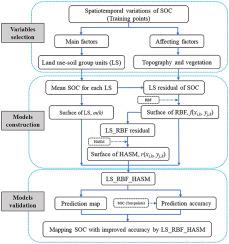Journal of Environmental Management ( IF 8.0 ) Pub Date : 2021-09-16 , DOI: 10.1016/j.jenvman.2021.113718 Youlin Luo 1 , Kai Wang 2 , Huanxiu Li 3 , Changquan Wang 4 , Qiquan Li 4

|
Accurate mapping of soil organic carbon (SOC) is critical to improve C management and develop sustainable management policies. However, it is constrained by local variations of the model parameters under complex topography, especially in hills. This study applied a methodological framework to optimize the spatial prediction of SOC in the hilly areas during 1981–2012 by quantifying the relative importance of environmental factors, which include both qualitative factors and quantitative variables. Results showed that SOC increased twofold with a moderate spatial dependence during the past 32 years. During this period, land use patterns, soil groups, topographic factors, and vegetation coverage had significant impacts on the SOC changes (p < 0.01). Specifically, the impact of land use patterns has exceeded the impact of soil groups and became the dominant factor affecting SOC changes. Meanwhile, impacts from the topographic factors and vegetation coverage have substantially declined. Based on those results, a combinatorial approach (LS_RBF_HASM) was developed to map SOC using radial basis function neural network (RBF) and high accuracy surface modelling (HASM), and to generate more detailed spatial mapping relationships between SOC and the affecting factors. Compared with ordinary kriging (OK), land use-soil group units (LS) and HASM combined (LS_HASM), multiple linear regression (MLR) and HASM combined with LS (LS_MLR_HASM); LS_RBF_HASM showed a better performance with a decline of 6.3%–37.7% prediction errors and more accurate spatial patterns due to the quantitative combination of auxiliary environmental variables and more information on the SOC variations within local factors captured by RBF and HASM. Additionally, MLR may partially undermine the relationship of the internal spatial structure due to the highly nonlinear relation between SOC and environmental variables. This methodological framework highlights the optimization of more environmental factors and the calculation of spatial variability within local factors and provides a more accurate approach for SOC mapping in hills.
中文翻译:

组合方法在丘陵土壤有机碳图谱中的应用
准确绘制土壤有机碳 (SOC) 对改善碳管理和制定可持续管理政策至关重要。然而,它受到复杂地形下模型参数局部变化的限制,尤其是在丘陵中。本研究应用方法论框架,通过量化环境因素(包括定性因素和定量变量)的相对重要性,优化了 1981-2012 年丘陵地区 SOC 的空间预测。结果表明,在过去的 32 年中,SOC 增加了两倍,并具有适度的空间依赖性。在此期间,土地利用模式、土壤群、地形因素和植被覆盖度对 SOC 变化有显着影响(p < 0.01)。具体而言,土地利用方式的影响已超过土壤群的影响,成为影响SOC变化的主导因素。同时,地形因素和植被覆盖度的影响已大幅下降。基于这些结果,开发了一种组合方法 (LS_RBF_HASM) 来使用径向基函数神经网络 (RBF) 和高精度表面建模 (HASM) 映射 SOC,并在 SOC 和影响因素之间生成更详细的空间映射关系。与普通克里金法(OK)相比,土地利用-土壤组单元(LS)与HASM结合(LS_HASM)、多元线性回归(MLR)和HASM结合LS(LS_MLR_HASM);LS_RBF_HASM 表现更好,下降了 6.3%–37。由于辅助环境变量的定量组合和更多关于 RBF 和 HASM 捕获的局部因素内 SOC 变化的信息,7% 的预测误差和更准确的空间模式。此外,由于 SOC 与环境变量之间的高度非线性关系,MLR 可能会部分破坏内部空间结构的关系。该方法框架突出了更多环境因素的优化和局部因素内空间变异性的计算,并为山地 SOC 制图提供了更准确的方法。由于 SOC 与环境变量之间的高度非线性关系,MLR 可能会部分破坏内部空间结构的关系。该方法框架突出了更多环境因素的优化和局部因素内空间变异性的计算,并为山地 SOC 制图提供了更准确的方法。由于 SOC 与环境变量之间的高度非线性关系,MLR 可能会部分破坏内部空间结构的关系。该方法框架突出了更多环境因素的优化和局部因素内空间变异性的计算,并为山地 SOC 制图提供了更准确的方法。











































 京公网安备 11010802027423号
京公网安备 11010802027423号